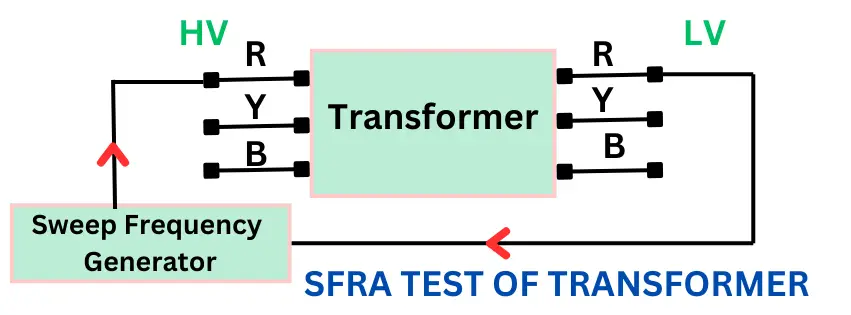The SFRA test of the transformer determines the physical condition of the transformer windings. Why is it crucial to carry out this test? After manufacturing, the transformer is transported to the factory site for final commissioning. During transportation, the transformer core and windings may experience mechanical stress, which may cause deformation of its components. Therefore, the transformer must be tested for the Sweep Frequency Response Analysis Test or SFRA Test before charging the transformer. The manufacturer does this SFRA test before transporting it to the vendor, and it is treated as a fingerprint of the transformer; these test results are the reference for future SFRA testing of the transformer.
The SFRA test determines the looseness of the magnetic core, dislocation of the winding, and any looseness in the transformer parts. If the transformer is charged before taking the SFRA test, the deformation of the winding or core may cause insulation failure, and the transformer may fail during charging. Therefore, the transformer manufacturer always recommends performing an SFRA test after the transformer is received at the user’s factory site.
In one more condition, you must perform the SFRA test on the transformer when a fault current flows through the transformer winding. The high fault current causes heavy mechanical stress on the core and winding, and it may cause deformation of the core or windings. If you observe this type of short circuit fault, it is good to perform the SFRA test.
Principle of SFRA Test
Electrical equipment has resistance (R), inductance (L), and capacitance (C) as basic elements. Thus, an electric circuit is composed of an RLC circuit. Different electrical equipment has different values of R, L, and C. However, electrical equipment has some values of R, L, and C, and it can not have a non-zero value. If the electrical equipment with an RLC value receives a sweep frequency, it generates a pattern of output voltage that is a function of the variable-sweep frequency. The sweep frequency is the frequency signal ranging between 10 Hz to 2MHz with a fixed magnitude.
The transformer winding is made of copper or aluminum conductors; thus, it has resistance and inductance. The paper insulation between turns forms a capacitance between the winding and the transformer’s core. Thus, the transformer winding is equivalent to a RLC circuit.
When sweep frequency is applied to the transformer winding, we will get different responses for the variable frequency, and this unique frequency response indicates the healthiness of the transformer winding and core.
Important Point: The SFRA test of the transformer is a comparative test, and the first test carried out on the transformer by the manufacturer before dispatch is considered a reference test. The test results of the SFRA test must be compared with the reference test to determine the healthiness of the transformer.
The Procedure of the SFRA Test:

- Connect one end of the transformer winding to the source end of the sweep frequency generator and the other end of the winding to the generator’s measure point.
- You can vary the frequency of the sweep frequency generator between 10Hz and 2 MHz, keeping its magnitude constant. Feed the sweep frequency to one of the windings, keeping the other windings open-circuited. Now, increase the sweep frequency, and the sweep frequency generator records the output voltage with increased frequency.
- The output voltage pattern in response to the changing frequency is observed and displayed on the sweep frequency generator.
- The pattern obtained on the generator is compared with the initial graph or pattern of the SFRA test after transformer manufacturing. The initial SFRA graph is also called the unique signature.
- If there is no deviation between the unique signature of the SFRA test and the test carried out following the above steps, then the mechanical integrity of the transformer core and windings is intact.
- Repeat the above steps for the remaining two windings and record the sweep frequency responses.
- Superimpose the sweep frequency responses obtained under the test with the initial SFRA test, and if deviation is found, it shows some mechanical deformation.
The following SFRA test graph shows the defect in a transformer’s winding and core.

Benefits of SFRA Test
- You can ensure the healthiness of the transformer by doing this simple SFRA test.
- It is possible to know the physical condition of the windings of different phases at the same tap position.
- The same rating of the transformers can be checked based on the transformer’s SFRA test.
- You can find the open and short-circuited turns of the winding.
- Looseness in the core, loose clamps, broken clamps, and bolts can be found with the SFRA test,